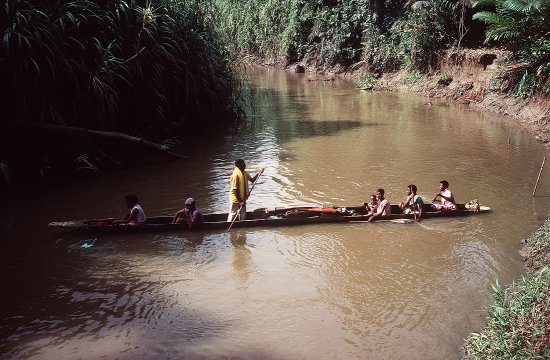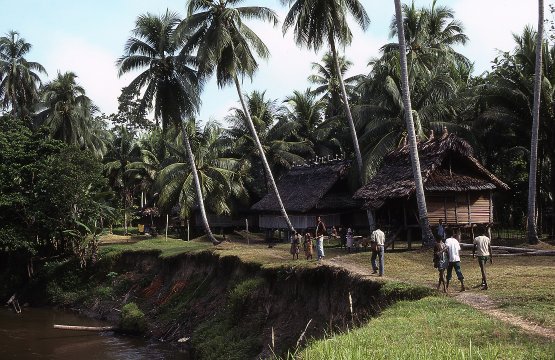|
John Tyman's Cultures in Context Series Torembi and the Sepik A Study of Village Life in New Guinea |
|
Topic No. 4: The Village |
|
John Tyman's Cultures in Context Series Torembi and the Sepik A Study of Village Life in New Guinea |
|
Topic No. 4: The Village |
 |
| 036. The village of Torembi is one of several inhabited by members of the Sawos tribe. It lies mostly within the forest, but on the edge of the kunai. |
 |
| 037. It is adjacent to a small stream (the Kwatit) which, close to sea level, winds to and fro among the trees. |
 |
| 038. Ten kilometres downstream it joins the Sepik, so the people of Torembi are able to draw on the resources of all four environments – forest, grassland, swamp grassland and swamp woodland. |
 |
| 039. On the Sepik Plains today a village typically consists of lines of houses strung out on either side of a track. |
 |
| 040. In Torembi’s case, however, there are 3 villages, not one, plus a mission. |
 |
| 042. It is the largest of the 3, and has almost a thousand people. There are 3 or 4 lines of houses, more or less parallel to the forest path. |
 |
| 044. The new village -- Torembi 2 -- grew up alongside of the river and now it has a population of 200. |
 |
| 047. Flooding was a problem, though, so as the village grew, new homes were built away from the river. |
 |
| 048. Most of these were located on the edge of the forest, where the trail from Torembi 2 joined the main track which linked the Mission to the Sepik. |
 |
| 049. Torembi Mission was established in 1950, in a grassy area at the northern end of the village, where there was room for a landing strip. |
 |
| 050. With its church, its clinic, school, post office, passenger and airfreight services, the Mission has served as a doorway through which new ideas have penetrated the community. |
![]()

![]()
Back to
Cultures in Context Intro: Photos & Recordings
![]()
Text, photos and recordings
by John Tyman
Intended for Educational Use
Only.
Copyright Pitt Rivers Museum,
Oxford University, 2010.
Contact Dr.
John Tyman for more information regarding licensing.
![]()
www.hillmanweb.com
Photo processing, Web page layout,
formatting, and complementary research by
William Hillman ~ Brandon, Manitoba
~ Canada